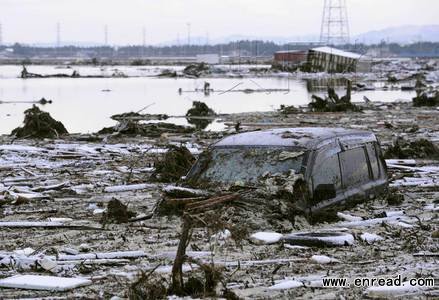| ||||||||||||||||||||||||||||||||||||||||||||||||||||||||||||||||||||||||
|
The massive earthquake that struck northeast Japan Friday (March 11) has shortened the length of Earth's day by a fraction and shifted how the planet's mass is distributed. 上周五(3月11日)袭击日本东北部的巨大地震使地球每日时长略有缩短,还改变了全球的质量分布。  The March 11 quake was the largest ever recorded in Japan and is the world\s fifth largest earthquake to strike since 1900, according to the USGS. Gross refined his estimates of the Japan quake's impact – which previously1 suggested a 1.6-microsecond shortening of the day – based on new data on how much the fault that triggered the earthquake slipped to redistribute(重新分配) the planet's mass. A microsecond is a millionth of a second. "By changing the distribution of the Earth's mass, the Japanese earthquake should have caused the Earth to rotate a bit faster, shortening the length of the day by about 1.8 microseconds," Gross told SPACE.com in an e-mail. More refinements2 are possible as new information on the earthquake comes to light, he added. The scenario3 is similar to that of a figure skater drawing her arms inward during a spin to turn faster on the ice. The closer the mass shift during an earthquake is to the equator(赤道) , the more it will speed up the spinning Earth. One Earth day is about 24 hours, or 86,400 seconds, long. Over the course of a year, its length varies by about one millisecond, or 1,000 microseconds, due to seasonal4 variations in the planet's mass distribution such as the seasonal shift of the jet stream(急流) . The initial data suggests Friday's earthquake moved Japan's main island about 8 feet, according to Kenneth Hudnut of the U.S. Geological Survey. The earthquake also shifted Earth's figure axis5 by about 6 1/2 inches (17 centimeters), Gross added. The Earth's figure axis(轴) is not the same as its north-south axis in space, which it spins around once every day at a speed of about 1,000 mph (1,604 kph). The figure axis is the axis around which the Earth's mass is balanced and the north-south axis by about 33 feet (10 meters). "This shift in the position of the figure axis will cause the Earth to wobble(摇摆) a bit differently as it rotates, but will not cause a shift of the Earth's axis in space – only external forces like the gravitational attraction of the sun, moon, and planets can do that," Gross said. The March 11 quake was the largest ever recorded in Japan and is the world's fifth largest earthquake to strike since 1900, according to the USGS. It struck offshore6 about 231 miles (373 kilometers) northeast of Tokyo and 80 miles (130 km) east of the city of Sendai, and created a massive tsunami7 that has devastated8 Japan's northeastern coastal9 areas. At least 20 aftershocks registering a 6.0 magnitude or higher have followed the main temblor. 点击  收听单词发音 收听单词发音
|
||||||||||||||||||||||||||||||||||||||||||||||||||||||||||||||||||||||||
上一篇:中国将在2016年前研制并发射空间实验室 下一篇:日本地震与“超级月亮”无关 |
||||||||||||||||||||||||||||||||||||||||||||||||||||||||||||||||||||||||
- 发表评论
-
- 最新评论 进入详细评论页>>



